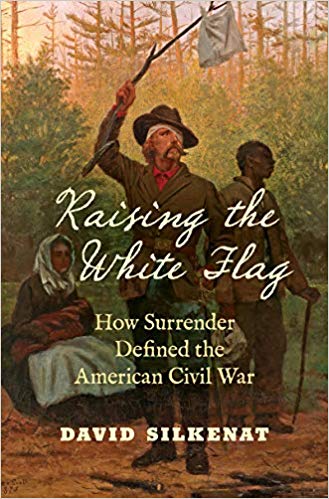Raising the White Flag: How Surrender Defined the American Civil War by David Silkenat. University of North Carolina Press, 2019. Cloth, ISBN: 978-1-4696-4972-6. $39.95.
 In this fascinating treatment of a long neglected topic, David Silkenat explores how Civil War-era Americans made sense of surrender as both an idea and practice—as well as how its meaning evolved over the course of the conflict. When the guns fell silent in Charleston Harbor on April 13, 1861, the capitulation of Major Robert Anderson’s Fort Sumter garrison not only prevented “the further effusion of blood,” but also forged the paradigmatic standard of “honorable surrender” for the duration of the internecine war. Both loyal and secessionist publics expected subsequent commanders facing surrender during the conflict to behave just as Anderson did, fighting desperately until any objective observer would conclude that further resistance was both futile and strategically pointless—all the while keeping their passions in check and scrupulously protecting their personal honor and that of their command by avoiding disgraceful terms. Whether or not any given surrender had in fact been “honorable” was a highly subjective verdict levied retrospectively in the court of public opinion. Absent any formal doctrine governing when or how Civil War officers were to surrender their commands should the unfortunate necessity arise, adhering to the expectations of an unforgiving public proved a perilous exercise for those facing hopeless tactical situations in the field.
In this fascinating treatment of a long neglected topic, David Silkenat explores how Civil War-era Americans made sense of surrender as both an idea and practice—as well as how its meaning evolved over the course of the conflict. When the guns fell silent in Charleston Harbor on April 13, 1861, the capitulation of Major Robert Anderson’s Fort Sumter garrison not only prevented “the further effusion of blood,” but also forged the paradigmatic standard of “honorable surrender” for the duration of the internecine war. Both loyal and secessionist publics expected subsequent commanders facing surrender during the conflict to behave just as Anderson did, fighting desperately until any objective observer would conclude that further resistance was both futile and strategically pointless—all the while keeping their passions in check and scrupulously protecting their personal honor and that of their command by avoiding disgraceful terms. Whether or not any given surrender had in fact been “honorable” was a highly subjective verdict levied retrospectively in the court of public opinion. Absent any formal doctrine governing when or how Civil War officers were to surrender their commands should the unfortunate necessity arise, adhering to the expectations of an unforgiving public proved a perilous exercise for those facing hopeless tactical situations in the field.
Public expectations for “honorable surrender” made little difference to lower-ranking combatants facing imminent mortality in the chaos of battle. Unlikely to suffer ignominy in the eyes of similarly embattled comrades, the right moment to throw down one’s weapon and throw up one’s hands became “an almost unconscious choice” for soldiers, driven mostly by survival instincts (73). Even so, Silkenat traces the evolutionary trajectory of soldiers’ “culture of surrender,” which, he argues, informed the expectations of those in the ranks facing the immediate prospect of capture. Whether or not a soldier felt he could count on mercy from the enemy and swift release from imprisonment by exchange influenced his willingness to either give in or fight to the death. During the yearlong tenure of the Dix-Hill prisoner exchange cartel, from the second to third summer of the war, most white soldiers assumed they would receive merciful quarter upon surrender and relatively rapid exchange. The ardent refusal of rebel authorities to exchange (or often even take) black prisoners, eventually leading to the cartel’s demise, along with bloody atrocities like those at Fort Pillow and rumors of unspeakable conditions in prison camps, challenged soldier suppositions that surrender was preferable to (or even distinct from) death. Although Silkenat asserts that this cultural transformation in the latter years of the war led to a greater tendency of beleaguered troops to fight to the bitter end, little evidence is offered in support. Indeed, the tens of thousands captured on both sides during the Atlanta and Overland campaigns of 1864 almost certainly threw up their hands primarily in the interest of saving their lives, just as many of the very same men had done at Pittsburg Landing or along the James Peninsula in 1862.
One particularly fascinating chapter re-examines the narrative of the battle of Gettysburg through the lens of surrender. Although considerably more men surrendered over the course of the three-day battle than were killed, their experiences have been overshadowed in popular memory by the extensive loss of life on that field. Many of those who instinctively threw up their arms along the Chambersburg Pike, on the slopes of Little Round Top, or at the dramatic climax of Pickett’s Charge (where at least twice as many Rebels surrendered as died), had surrendered at least once before in their military careers and naturally expected similar treatment. Sadly, the collapse of the Dix-Hill cartel instead sent many to deadly prison camps, frighteningly large numbers of whom would never leave.
No study of surrender during the war would be complete without addressing the famous policy of “unconditional surrender” most popularly associated with generals Ulysses Grant and Nathan Bedford Forrest. In comparing the disparate tactical and strategic employment of the policy by both generals, Silkenat deftly illustrates the ways in which the individual personalities of commanders and their respective “philosophies of surrender” could powerfully shape the character of Civil War surrenders (167). Whereas Forrest, the relentless slave-trading cavalier, reveled in his capacity to assert Southern masculine dominance by compelling enemies to surrender sans terms out of fear for their lives, the no-nonsense Westerner Grant always cut straight to the chase with his similarly uncompromising terms, but habitually, to use President Lincoln’s phrase, “let ’em up easy” – most significantly and famously at Appomattox.
Moving beyond a thematic structure, the second half of the volume provides succinct but thorough case studies of every major Rebel surrender of 1865, highlighting their many qualitative connections, continuities, and differences. While the proceedings of the most famous of these at Appomattox resembled large-scale surrenders earlier in the war, the event also played a powerful role in shaping all Rebel surrenders that followed. Lee’s capitulation “created a tumultuous thunder that reverberated … across the Confederacy,” sending a powerful signal to all Secessionists still in the field that the end was nigh (189). Later chapters analyze the surrenders of Rebel armies in the Western and Trans-Mississippi theaters – topics addressed more comprehensively by other authors, but never with an eye toward situating them within the broader cultural context of Civil War surrenders as a whole. This, in many ways, represents Silkenat’s greatest contribution to our understanding of these pivotal events, erstwhile traditionally treated merely as conclusions to operational narratives of campaigns.
If surrender never quite “defined” the war, this book makes clear that it unquestionably suffused it. Indeed, it is in large part surrender’s striking ubiquity throughout the conflict that Silkenat finds so paradoxical in a war destined to play such a major role in the formation of American cultural identity. That paradox, he argues, is in large part responsible for the lingering reluctance of Americans to both acknowledge and commemorate surrender as a central aspect of the wartime experience for many hundreds of thousands of soldiers in blue and gray. At the same time, he is apt to point out that it is well that the option of capitulation remained consciously on the table for these men, as without any opportunity “to prevent the further effusion of blood,” the already abysmal amount of carnage likely would have risen to an exponentially greater scale.
Michael Burke is a doctoral candidate in military history at the University of North Carolina, Chapel Hill.
